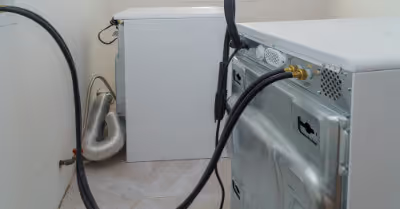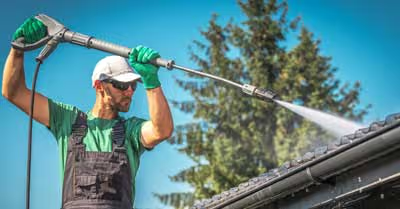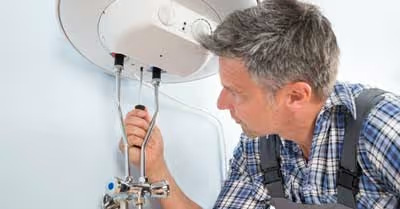Table of Contents
Termite Damage
Termites are detritivores which means they usually feed on dead vegetation. They get their nutrients from cellulose. Termites have bacteria and protozoa in their stomachs that break down the cellulose.
Cellulose is a fiber that is found in wood and plants. Termites will eat anything that contains cellulose even though they usually feed on wood. This means they will even eat paper, carpet, insulation, sheetrock, drywall, and some fabrics. This can be more than a nuisance because they can literally eat away at the structure of your home.
Lots of people believe that their home is safe from termites because it is not primarily constructed of wood. However, homes that are not made of wood can also be destroyed by termite infestations because termites will travel through other materials. Even if the home or building is constructed by a material that does not contain cellulose, like metal, termites often find their way in to devour the materials that they crave. They will eat away at cabinets, flooring, furniture, ceilings, and more.
It is important to know the signs of termites in any area of your home so that you can eliminate them before they cause more damage.
Wood or Laminate Flooring
Termites will eat away at the floorboards and often go undetected because they may not cause visible damage. However, sometimes the floors will appear waterlogged or swollen. Often, the only sign of floor damage from termites comes with a change in the sound. If your floor begins to squeak where it never did before, then there may be damage from termites. Additionally, severe damage in the floor will leave cavities which can cause a hollow sound. If you suspect you have termites elsewhere, you may want to tap on the floorboards with your head down to see if you hear any telling sounds.
Ceiling
Termites can cause significant damage to the ceiling. The appearance of cracked ceilings is a telltale sign because they eat the structure away and the wood then shifts. The ceilings may also buckle or sag. Sometimes homeowners mistake termite damage for water sitting in their attic.
Foundation
Termites can eat away the wood sources around the concrete foundation even though they cannot eat the foundation itself. They will eat all the wooden parts away while leaving any concrete, metal, soil, and other materials. They often enter the home through tunnels in the small, thin cracks of the foundation.
Carpet
Many people do not realize that termites can eat things other than wood. If your carpet is getting unusually worn in places that seem odd, then it may be because you have termites. The carpet may also seem to fray away and separate from the baseboards around the edges.
Categories of Termites
Sometimes structural damage occurs before the homeowner is even aware of a termite problem. If you suspect or know that you have termites, it is best to act quickly. There are three main categories of termites: Drywood termites, Dampwood termites, and Subterranean termites. There are lots of species of termites that fit into these three categories. Check out this spreadsheet to see lots of types, their appearances, and the regions where they are found.
Drywood Termites
Drywood termites live within the wood that they eat. Sometimes they go unnoticed until the wood shows cracks. Sometimes, however, you may be able to see the sawdust that they leave behind. Usually, they will eat away at your home more slowly than dampwood and subterranean termites.
Dampwood Termites
Since dampwood termites eat moist or decaying wood, they are rarely found inside homes. However, they are sometimes present when there is a leak in the house. They often eat wood across the grain. As with other termites, they may leave sawdust behind.
Subterranean Termites
Subterranean termites are known for their tall mounds that look like mud skyscrapers. However, if they are eating away at your home their presence may be less obvious. The damage caused by subterranean termites often seems like water damage to some homeowners. The floors and ceilings may appear swollen and the wood may even buckle. In addition, an odor similar to mildew may be present.
Termite Timeline
Termites can cause significant damage to your home, but how long does it take? Sometimes the damage does not get noticed for years. By then, the damage will likely be extensive and costly. A single termite is not very destructive and would take thousands of years to eat your house. However, a termite infestation can eat up to a pound of wood in a single day.
It can take a while before your home suffers any significant termite damage. The amount of damage depends greatly on the size of the termite colony. Damage can occur within a few years for larger infestations. Significant damage could then occur within a decade. Typically, when you first notice a termite swarm, the termites have already been eating at the home for three or more years.
How to Identify Termites
There are tons of types of termites that look unique. However, there are some similarities between most species of termites that you can look for. They are all fairly small and even the largest species rarely grow more than a half inch. They are usually light brown, but some will be off white as well.
You should also be aware of their different castes. Termites have three different castes that perform different jobs for the colony. The castes are workers, soldiers, and swarmers. Workers are usually the lightest colored of the three castes. They are generally the smallest and may even appear like larvae. Soldiers are usually darker than the workers and have hard heads. They also have mandibles and will grow wings when they are fully mature. Finally, the swarmers have wings and very dark exoskeletons. Their wings will be larger than their body.
How Much Does Termite Damage Cost?
Termites damage hundreds of thousands of homes in the United States each year adding up to an estimated $5 billion per year spent on termite control and repaired termite damage. The average cost for a homeowner to spend on termite damage is around $3000. Cosmetic repairs run at a little less than $2000 on average. However, the actual cost of termite damage can differ greatly depending on where the damage is located and how much is actually damaged.
In addition to the repairs you will have to eradicate the termites themselves which adds to the costs. The typical cost is between $5 and $7 per linear foot that the termites have damaged in your home. It is always best to prevent termites in the first place to avoid the stress and cost of these substantial repairs.
How to Prevent Termites
There are some things you can do to reduce the risk of a termite infestation. The first thing is to try to limit the amount of wood on the outside of your home. Termites are commonly attracted to wood piles around a house. Even mulch can attract termites so try not to use it too often. You can use pine needles instead of mulch because they do not attract termites as much.
It is also smart to try to avoid having moisture accumulate around the foundation or in the crawl spaces. Termites are attracted to the moisture, especially when it is located near a food source (like all the wood in your house). You can point sprinkler heads away from your foundation to limit the amount of water. You should also make sure that any crawl spaces have adequate ventilation.
You should also try to keep any vegetation around your home well-trimmed. This includes anything from bushes to large weeds. In addition, try to allow a foot of space between the vegetation and the sides of your house. This allows air in that will dry out the area.
You can also have your home treated for termites. This is a good idea if you live in an area that is known to have termite issues. It can also save you the worry of termites because you know you are protected.
Recent Articles
















